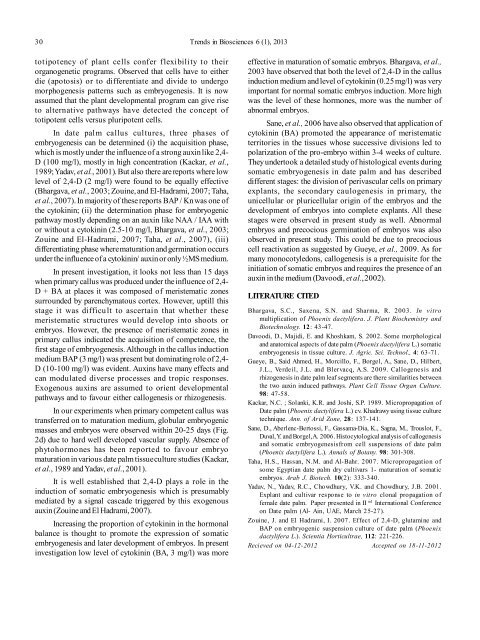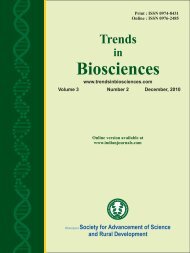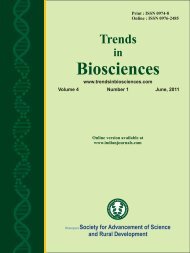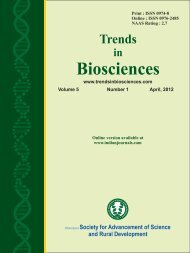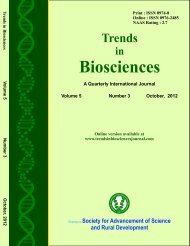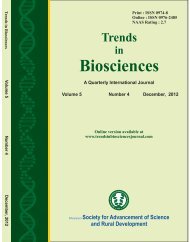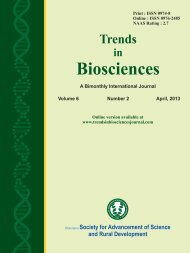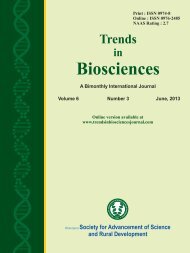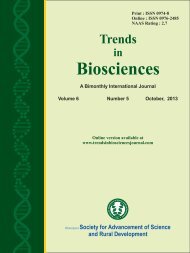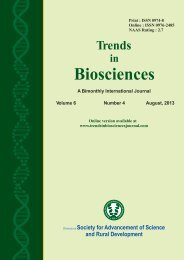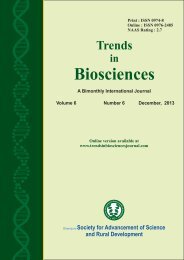TRENDS IN BIOSCIENCES 6-1, 2013 EDITION
CALL FOR RESEARCH PAPERS
CALL FOR RESEARCH PAPERS
Create successful ePaper yourself
Turn your PDF publications into a flip-book with our unique Google optimized e-Paper software.
30 Trends in Biosciences 6 (1), <strong>2013</strong><br />
totipotency of plant cells confer flexibility to their<br />
organogenetic programs. Observed that cells have to either<br />
die (apotosis) or to differentiate and divide to undergo<br />
morphogenesis patterns such as embryogenesis. It is now<br />
assumed that the plant developmental program can give rise<br />
to alternative pathways have detected the concept of<br />
totipotent cells versus pluripotent cells.<br />
In date palm callus cultures, three phases of<br />
embryogenesis can be determined (i) the acquisition phase,<br />
which is mostly under the influence of a strong auxin like 2,4-<br />
D (100 mg/l), mostly in high concentration (Kackar, et al.,<br />
1989; Yadav, et al., 2001). But also there are reports where low<br />
level of 2,4-D (2 mg/l) were found to be equally effective<br />
(Bhargava, et al., 2003; Zouine, and El-Hadrami, 2007; Taha,<br />
et al., 2007). In majority of these reports BAP / Kn was one of<br />
the cytokinin; (ii) the determination phase for embryogenic<br />
pathway mostly depending on an auxin like NAA / IAA with<br />
or without a cytokinin (2.5-10 mg/l, Bhargava, et al., 2003;<br />
Zouine and El-Hadrami, 2007; Taha, et al., 2007), (iii)<br />
differentiating phase where maturation and germination occurs<br />
under the influence of a cytokinin/ auxin or only ½MS medium.<br />
In present investigation, it looks not less than 15 days<br />
when primary callus was produced under the influence of 2,4-<br />
D + BA at places it was composed of meristematic zones<br />
surrounded by parenchymatous cortex. However, uptill this<br />
stage it was difficult to ascertain that whether these<br />
meristematic structures would develop into shoots or<br />
embryos. However, the presence of meristematic zones in<br />
primary callus indicated the acquisition of competence, the<br />
first stage of embryogenesis. Although in the callus induction<br />
medium BAP (3 mg/l) was present but dominating role of 2,4-<br />
D (10-100 mg/l) was evident. Auxins have many effects and<br />
can modulated diverse processes and tropic responses.<br />
Exogenous auxins are assumed to orient developmental<br />
pathways and to favour either callogenesis or rhizogenesis.<br />
In our experiments when primary competent callus was<br />
transferred on to maturation medium, globular embryogenic<br />
masses and embryos were observed within 20-25 days (Fig.<br />
2d) due to hard well developed vascular supply. Absence of<br />
phytohormones has been reported to favour embryo<br />
maturation in various date palm tissue culture studies (Kackar,<br />
et al., 1989 and Yadav, et al., 2001).<br />
It is well established that 2,4-D plays a role in the<br />
induction of somatic embryogenesis which is presumably<br />
mediated by a signal cascade triggered by this exogenous<br />
auxin (Zouine and El Hadrami, 2007).<br />
Increasing the proportion of cytokinin in the hormonal<br />
balance is thought to promote the expression of somatic<br />
embryogenesis and later development of embryos. In present<br />
investigation low level of cytokinin (BA, 3 mg/l) was more<br />
effective in maturation of somatic embryos. Bhargava, et al.,<br />
2003 have observed that both the level of 2,4-D in the callus<br />
induction medium and level of cytokinin (0.25 mg/l) was very<br />
important for normal somatic embryos induction. More high<br />
was the level of these hormones, more was the number of<br />
abnormal embryos.<br />
Sane, et al., 2006 have also observed that application of<br />
cytokinin (BA) promoted the appearance of meristematic<br />
territories in the tissues whose successive divisions led to<br />
polarization of the pro-embryo within 3-4 weeks of culture.<br />
They undertook a detailed study of histological events during<br />
somatic embryogenesis in date palm and has described<br />
different stages: the division of perivascular cells on primary<br />
explants, the secondary caulogenesis in primary, the<br />
unicellular or pluricellular origin of the embryos and the<br />
development of embryos into complete explants. All these<br />
stages were observed in present study as well. Abnormal<br />
embryos and precocious germination of embryos was also<br />
observed in present study. This could be due to precocious<br />
cell reactivation as suggested by Gueye, et al., 2009. As for<br />
many monocotyledons, callogenesis is a prerequisite for the<br />
initiation of somatic embryos and requires the presence of an<br />
auxin in the medium (Davoodi, et al., 2002).<br />
LITERATURE CITED<br />
Bhargava, S.C., Saxena, S.N. and Sharma, R. 2003. In vitro<br />
multiplication of Phoenix dactylifera. J. Plant Biochemistry and<br />
Biotechnology. 12: 43-47.<br />
Davoodi, D., Majidi, E. and Khoshkam, S. 2002. Some morphological<br />
and anatomical aspects of date palm (Phoenix dactylifera L.) somatic<br />
embryogenesis in tissue culture. J. Agric. Sci. Technol., 4: 63-71.<br />
Gueye, B., Said Ahmed, H., Morcillo, F., Borgel, A., Sane, D., Hilbert,<br />
J.L., Verdeil, J.L. and Blervacq, A.S. 2009. Callogenesis and<br />
rhizogenesis in date palm leaf segments are there similarities between<br />
the two auxin induced pathways. Plant Cell Tissue Organ Culture.<br />
98: 47-58.<br />
Kackar, N.C. ; Solanki, K.R. and Joshi, S.P. 1989. Micropropagation of<br />
Date palm (Phoenix dactylifera L.) cv. Khadrawy using tissue culture<br />
technique. Ann. of Arid Zone, 28: 137-141.<br />
Sane, D., Aberlenc-Bertossi, F., Gassama-Dia, K., Sagna, M., Trouslot, F.,<br />
Duval, Y. and Borgel, A. 2006. Histocytological analysis of callogenesis<br />
and somatic embryogenesisfrom cell suspensions of date palm<br />
(Phoenix dactylifera L.). Annals of Botany. 98: 301-308.<br />
Taha, H.S., Hassan, N.M. and Al-Bahr. 2007. Micropropagation of<br />
some Egyptian date palm dry cultivars 1- maturation of somatic<br />
embryos. Arab J. Biotech. 10(2): 333-340.<br />
Yadav, N., Yadav, R.C., Chowdhury, V.K. and Chowdhury, J.B. 2001.<br />
Explant and cultivar response to in vitro clonal propagation of<br />
female date palm. Paper presented in II nd International Conference<br />
on Date palm (Al- Ain, UAE, March 25-27).<br />
Zouine, J. and El Hadrami, I. 2007. Effect of 2,4-D, glutamine and<br />
BAP on embryogenic suspension culture of date palm (Phoenix<br />
dactylifera L.). Scientia Horticultrae, 112: 221-226.<br />
Recieved on 04-12-2012 Accepted on 18-11-2012


